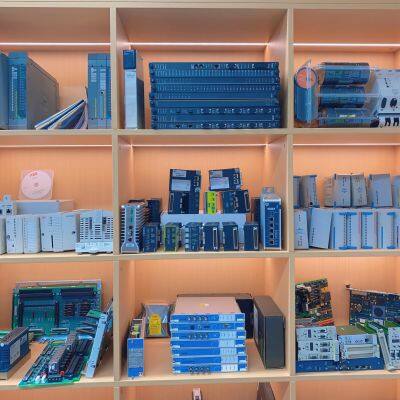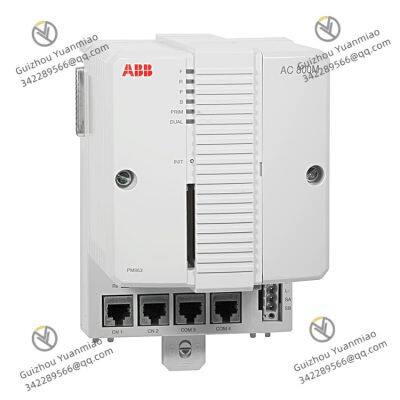Product Description
ABB PM891K01 3BSE053241R1 Processor Unit
The ABB PM863K01 (Order Number: 3BSE088381R1) is the core processor unit of ABB Industrial Automation’s AC 800M Distributed Control System (DCS). Positioned as a "mid-to-high-end integrated unit for process control and logic control", it is specifically designed for continuous process control (e.g., chemical reactions, power boiler regulation), discrete logic control (e.g., start/stop of mechanical equipment), and complex process interlock protection in industrial sites. Leveraging a high-performance hardware architecture, redundant fault-tolerant design, and open communication protocols, it is widely used in petrochemical, power, metallurgy, water treatment, and other fields with extremely high requirements for control accuracy and system reliability. It serves as a key core device for realizing industrial production automation, intelligence, and safe operation. The following provides a detailed explanation from dimensions including model identification, technical parameters, hardware structure, core functions, application scenarios, and operation and maintenance characteristics, ensuring the professionalism and completeness of the information.
I. Interpretation of Model and Order Number
PM863K01 and 3BSE088381R1 are core identifiers in ABB’s standardized naming system, corresponding to the product model and unique order code respectively. Their specific meanings are as follows:

II. Core Technical Parameters1. Basic Electrical and Environmental Parameters
2. Core Computing and Storage Parameters
3. Communication Interface Parameters
The PM863K01 supports a hierarchical communication architecture with "multi-protocol and multi-interface", covering the full-link data interaction of "Controller-I/O", "Controller-Controller", and "Controller-Host Computer". The specific interface specifications are as follows:
II. Hardware Structure and Core Components
The PM863K01 adopts a "modular and highly integrated" hardware design. Its internal core components are layered according to "computing-storage-communication-redundancy-status indication", ensuring independent functions and efficient collaboration. The specific structure is as follows:
1. Core Computing Unit (CPU Module)
Processor Chip: Adopts an industrial-grade processor based on the PowerPC architecture (800MHz clock speed) with an integrated hardware Floating-Point Unit (FPU). It can quickly process complex process control algorithms (e.g., PID auto-tuning, Model Predictive Control (MPC)) and large-scale logic interlocks (e.g., Emergency Shutdown (ESD) logic), with a computing response time ≤ 100μs (per logic instruction).
Co-Processing Unit: Built-in dedicated communication coprocessor (independent of the main CPU), responsible for processing data transmission and reception of communication protocols such as Profinet and Ethernet. This prevents communication loads from occupying the main CPU resources, ensuring the real-time performance of control computing is not affected by communication.
2. Storage Unit
Flash Memory: 16MB industrial-grade Flash, used to solidify ABB system firmware (e.g., AC 800M Operating System V6.0 and above), user control programs (written in APROL or Control Builder M software), and hardware configuration parameters. It supports online erasing and program updates (no module disassembly required).
RAM Memory: 128MB high-speed SRAM, paired with a supercapacitor (capacity 0.5F, lifespan ≥ 10 years) to achieve "power-off data backup". When external power is interrupted, the supercapacitor can maintain RAM data retention for ≥ 72h. After power recovery, operation can resume without reloading the program, avoiding production interruptions.
SD Card Expansion Interface: One microSD card slot (supporting maximum 32GB SDHC cards) is provided on the front panel, used for manual backup/restoration of user programs and storage of system logs (e.g., fault records, operation records), facilitating offline analysis and version tracing.
3. Communication Interface Unit
Profinet IRT Interface: 2 RJ45 ports, supporting "real-time cyclic communication" and "acyclic data interaction" of the Profinet IRT protocol. They can directly connect to AC 800M local I/O modules (e.g., AI830 analog input module, DO840 digital output module), supporting a maximum of 256 I/O points (per controller) and hot-swap of I/O modules (control loops operate without disturbance when modules are replaced live).
Ethernet Interface: 2 Gigabit Ethernet RJ45 ports, supporting dual-network card redundancy configuration (link backup via ABB redundancy protocol). They can connect to host monitoring systems (e.g., ABB APROL HMI, third-party SCADA systems), engineering stations (for program writing and debugging), or other AC 800M controllers (for multi-controller collaborative control). They support Modbus TCP client/server mode and can communicate with third-party devices (e.g., frequency converters, intelligent meters).
RS-232 Maintenance Interface: 1 DB9 female RS-232 port, used for local connection to engineering stations (laptops). Through ABB Service Tool software, it enables controller firmware upgrades, fault diagnosis (e.g., checking CPU load and memory usage), and program downloads, suitable for on-site operation and maintenance in environments without Ethernet.
4. Redundancy and Fault-Tolerance Unit
Redundancy Synchronization Interface: 1 dedicated redundancy link interface (connected via ABB-specific cables). When two PM863K01 units are configured for "master-standby redundancy", this interface synchronizes the I/O data, control status, and program variables of the master controller to the standby controller in real time, with a synchronization delay ≤ 10μs, ensuring "complete consistency of states" between the master and standby controllers.
Redundancy Switching Logic: Built-in hardware-level redundancy switching circuit. When the master controller fails (e.g., CPU abnormality, communication interruption), the standby controller can automatically switch to "master mode" within ≤ 50ms, and the control output remains undisturbed during the switching process (e.g., valve opening and motor speed remain unchanged), meeting the "uninterrupted operation" requirement of industrial production (Mean Time Between Failures (MTBF) ≥ 100,000h).
III. Core Functions and Technical Characteristics
As the core of the AC 800M system, the PM863K01 integrates four core capabilities: "process control, logic control, redundancy fault tolerance, and open integration", meeting diverse control needs of industrial sites. Its specific functions are as follows:
1. Integrated High-Precision Process Control and Logic Control
Process Control Algorithms: Supports ABB’s full range of process control function blocks, including:
Basic regulation: Standard PID (supporting independent tuning of proportional/integral/derivative parameters), cascade PID (e.g., boiler water level-steam pressure cascade control), ratio control (e.g., chemical raw material ratio regulation);
Advanced regulation: PID auto-tuning (automatic optimization of PID parameters via ABB patented algorithms to adapt to load changes), feedforward control (offsetting predictable disturbances, such as the impact of feed temperature fluctuations on reactor temperature), Model Predictive Control (MPC, suitable for multi-variable coupled systems, such as refinery distillation towers);
Special functions: Batch control (for batch production processes in pharmaceuticals and food industries, supporting recipe management and batch tracing), cumulative calculation (e.g., flow accumulation, energy consumption statistics).
Logic Control Functions: Supports all programming languages specified in the IEC 61131-3 standard (Ladder Diagram (LD), Function Block Diagram (FBD), Structured Text (ST), Sequential Function Chart (SFC)). It can compile large-scale logic interlock programs (e.g., Emergency Shutdown (ESD) systems, equipment start/stop interlocks), supporting a maximum of 10,000 logic instructions (per controller), with a logic execution cycle configurable from 1ms to 1s (on-demand configuration).
2. Redundancy Fault Tolerance and High-Reliability Design
Controller Dual-Machine Redundancy: Supports "1+1" master-standby redundancy configuration (two PM863K01 modules connected via redundancy cables). The master controller synchronizes data to the standby controller in real time. When the master controller fails, the standby controller switches without disturbance within ≤ 50ms, ensuring continuous control output (e.g., no fluctuations in valve opening and motor speed), meeting the reliability requirements of "no shutdown allowed" scenarios such as petrochemical and nuclear power industries.
Hardware Fault Self-Diagnosis: Built-in comprehensive hardware diagnosis functions, which can real-time monitor the status of CPU computing, memory reading/writing, communication links, power voltage, and module temperature. When a fault (e.g., RAM error, communication interruption) is detected, it immediately triggers an "ERR light alarm" and sends a fault code (e.g., "E001-CPU Abnormality", "E005-Profinet Link Interruption") to the host computer, facilitating maintenance personnel to quickly locate problems.
Anti-Interference Design: The hardware adopts three anti-interference measures: "power isolation", "signal shielding", and "ground protection". The power input end integrates an EMI filter (suppressing power grid harmonic interference), the communication interface uses differential signal transmission (resisting electromagnetic radiation interference), and the module housing has a ground resistance ≤ 1Ω (discharging electrostatic interference), ensuring stable operation in industrial strong-interference environments (e.g., motor startup, frequency converter operation).
 II. Core Technical Parameters1. Basic Electrical and Environmental Parameters2. Core Computing and Storage Parameters3. Communication Interface Parameters
II. Core Technical Parameters1. Basic Electrical and Environmental Parameters2. Core Computing and Storage Parameters3. Communication Interface Parameters

ABB 086348-001 PC Board
ABB 086444-005 Measurement Process Board
ABB RMU610 2VAA008425R1 Repeater Mounting Unit
ABB CHBX01L 2VAA008574R1 Compact Bus Extender
ABB CHBX01R 2VAA008575R1 Compact Bus Extender
ABB UFC921A 3BHE024856P106 Communication Module
ABB PP886 3BSE092980R1 Operation Panel
ABB SUE3000 1VCF750090R0804 Maintenance Exchange Unit
ABB SUE3000 1VCR007346 G0032 REF542plus HMI Unit
ABB GFD563A101 Interface Module
ABB 3BHE046836R0101 Interface Module
ABB UNS0881b-PV2 PCB Circuit Board
 yezi
Hi there! Welcome to my shop. Let me know if you have any questions.
yezi
Hi there! Welcome to my shop. Let me know if you have any questions.



